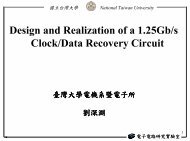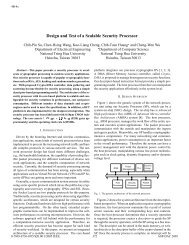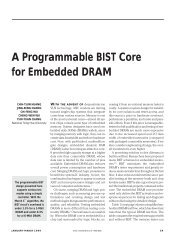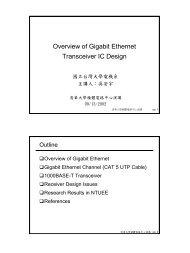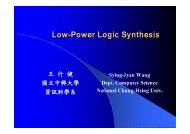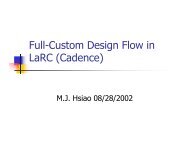Download
Download
Download
You also want an ePaper? Increase the reach of your titles
YUMPU automatically turns print PDFs into web optimized ePapers that Google loves.
CHAPTER 10<br />
Frequency Compensation<br />
Analog IC Analysis and Design 10-1<br />
Chih-Cheng Hsieh
Outline<br />
1. General Consideration<br />
2. Phase Margin<br />
3. Frequency Compensation<br />
4. Compensation of Two-Stage Op Amps<br />
5. Other Compensation Techniques<br />
Analog IC Analysis and Design 10-2<br />
Chih-Cheng Hsieh
General Consideration<br />
Y<br />
X<br />
( s)<br />
=<br />
H ( s)<br />
1+ βH<br />
( s)<br />
• Consider the negative feedback system, where β is assumed constant<br />
• If βH<br />
( s = jω1 ) = −1<br />
, the gain goes to infinity, and the circuit can amplify its own<br />
noise until it eventually begins to oscillate.<br />
• Barkhausen’s Criteria : The circuit may oscillate at frequency<br />
o<br />
( jω<br />
) = ∠βH<br />
( jω<br />
) =<br />
βH 180<br />
1<br />
1<br />
1<br />
−<br />
• The total phase shift around the loop at ω 1 is 360 o . (180 o from negative feedback)<br />
• The feedback signal add in phase to the original noise to allow oscillation buildup.<br />
ω 1<br />
if<br />
Analog IC Analysis and Design 10- Chih-Cheng Hsieh<br />
3
Bode Plot for Stability Analysis<br />
• Assume that β is less than or equal to unity and does not depend on the<br />
frequency.<br />
• The worst case stability corresponds to β = 1.<br />
• We often analyze the magnitude and phase plots for βH = H .<br />
Unstable<br />
Stable<br />
• In a stable system<br />
Gain<br />
20log βH<br />
Margin = −20log<br />
βH<br />
o<br />
( jω<br />
o ) < 0 ∠βH<br />
( jωunity<br />
) > −180<br />
180<br />
o<br />
( jω<br />
o ) Phase Margin = 180 + ∠βH<br />
( jω<br />
)<br />
180<br />
Analog IC Analysis and Design 10- Chih-Cheng Hsieh<br />
4<br />
unity
Time Response vs. the Position of Poles<br />
• Expressing each pole frequency as<br />
s<br />
p<br />
=<br />
jω + σ<br />
p<br />
p<br />
• The impulse response of the system<br />
includes a term<br />
exp(<br />
jω + σ )t<br />
p<br />
p<br />
Analog IC Analysis and Design 10- Chih-Cheng Hsieh<br />
5
Stability and Pole Location<br />
http://en.wikipedia.org/wiki/Laplace_transform<br />
Consider an amplifier with a complex-conjugate pole pair : s = σ0 ± jωn<br />
σ0 0<br />
( ) t [ j ωn<br />
t − j ωn<br />
t σ<br />
] 2 t cos( )<br />
vt = e e + e = e ω t<br />
A sinusoidal signal with an envelope<br />
n<br />
0<br />
e σ t<br />
Stable system<br />
Left-plane pole<br />
σ<br />
0<br />
< 0<br />
: Oscillation decays exponentially to zero.<br />
Analog IC Analysis and Design 10-6<br />
Chih-Cheng Hsieh
Stability and Pole Location<br />
Right-plane pole<br />
σ<br />
0<br />
> 0<br />
: Oscillation grows exponentially to nonlinear.<br />
Unstable system<br />
jw axis pole<br />
σ<br />
0<br />
= 0<br />
: Oscillation sustained.<br />
Oscillation system<br />
The existence of any righ-half-plane poles results in instability<br />
Analog IC Analysis and Design 10-7<br />
Chih-Cheng Hsieh
Bode Plots of Loop Gain<br />
• Consider an one pole amplifier<br />
A0<br />
H()<br />
s = ⎛<br />
1 s ⎞<br />
⎜ +<br />
ω ⎟<br />
⎝ 0 ⎠<br />
A0<br />
Y 1+<br />
β A<br />
() s =<br />
X<br />
1+<br />
s<br />
ω<br />
0<br />
( 1+<br />
βA<br />
)<br />
0 0<br />
• A single pole cannot contribute a phase shift greater than 90 o , and the system is<br />
unconditionally stable for all non-negative values of β.<br />
Analog IC Analysis and Design 10- Chih-Cheng Hsieh<br />
8
Two-pole Systems<br />
• Consider a two-pole system<br />
H()<br />
s<br />
0<br />
= ⎛<br />
1 s ⎞⎛<br />
1 s ⎞<br />
⎜ +<br />
ω ⎟⎜ +<br />
P1 ω ⎟<br />
⎝ ⎠⎝ P2⎠<br />
Y<br />
A0<br />
() s =<br />
X ⎛ s ⎞⎛ s ⎞<br />
1+ 1+ + β A<br />
⎜<br />
⎟⎜ ω ⎟⎜ ω ⎟<br />
A<br />
⎝ p1⎠⎝ p2<br />
⎠<br />
0<br />
• Maximum phase shift = 180 o<br />
• As the feedback becomes weaker, the gain crossover point moves toward the<br />
origin.<br />
• The stability is obtained at the cost of weaker feedback.<br />
Analog IC Analysis and Design 10- Chih-Cheng Hsieh<br />
9
Multipole Systems<br />
• Consider a 3-pole system<br />
• Maximum phase shift = 270 o<br />
• The phase begins to change at 0.1 of pole<br />
frequency whereas the magnitude begins to<br />
drop only near the pole frequency.<br />
• Additional poles(and zeros) impact the phase to<br />
a much greater extent than magnitude.<br />
• The stability is obtained at the cost of weaker<br />
feedback.<br />
Analog IC Analysis and Design 10- Chih-Cheng Hsieh<br />
10
Outline<br />
1. General Consideration<br />
2. Phase Margin<br />
3. Frequency Compensation<br />
4. Compensation of Two-Stage Op Amps<br />
5. Other Compensation Techniques<br />
Analog IC Analysis and Design 10-11<br />
Chih-Cheng Hsieh
Phase Margin<br />
• If<br />
o<br />
o<br />
( u ) 175 , ( 1) 1 exp( 175 )<br />
∠ βH jω =− βH jω<br />
= × −j<br />
1 exp 175<br />
Y H β<br />
1 −0. 9962 − j 0.<br />
0872<br />
( jω1<br />
) = = = ⋅<br />
X 1+ βH j ω 1+ exp − 175 β 0. 0038 − j 0.<br />
0872<br />
( jω1<br />
)<br />
( )<br />
1<br />
o<br />
( − j )<br />
o<br />
( j )<br />
Y<br />
X<br />
( jω<br />
)<br />
1 1<br />
⋅<br />
β 0.0872<br />
1<br />
= ≈<br />
11.5<br />
β<br />
Y<br />
1<br />
• Since at low frequencies, ≈<br />
X β , the closed-loop frequency response<br />
exhibits a sharp peak in the vicinity of ω = ω 1<br />
• The closed loop system is near oscillation and its step response exhibits a very<br />
underdamped behavior.<br />
Analog IC Analysis and Design 10- Chih-Cheng Hsieh<br />
12
Closed-Loop Freq. and Time Response<br />
‣ For a small phase margin<br />
log βH<br />
( ω)<br />
‣ For a large phase margin<br />
log βH<br />
( ω)<br />
∠βH ( ω)<br />
∠βH ( ω)<br />
• The greater the phase margin, the more stable the feedback system.<br />
Analog IC Analysis and Design 10- Chih-Cheng Hsieh<br />
13
CL Freq. Response with 45 o PM<br />
• For PM = 45 o ,<br />
∠βH<br />
o<br />
( ω ) = − βH<br />
( ω ) 1<br />
1<br />
135<br />
1<br />
=<br />
Y<br />
X<br />
H<br />
1<br />
=<br />
1+<br />
1×<br />
exp( − j135<br />
( jω<br />
) H ( jω<br />
)<br />
o<br />
)<br />
1<br />
=<br />
0.29 − 0.71j<br />
Y<br />
X<br />
=<br />
1<br />
⋅<br />
β<br />
1<br />
0.29 − 0.71j<br />
1.3<br />
≈<br />
β<br />
– The feedback system suffers from a 30% peak at ω = ω 1<br />
• For PM = 60 o , the peaking is negligible<br />
1<br />
=<br />
β<br />
• The concept of phase margin is well-suited to the<br />
design of circuits that process small signals, not large<br />
signals.<br />
Y<br />
X<br />
Analog IC Analysis and Design 10- Chih-Cheng Hsieh<br />
14
Outline<br />
1. General Consideration<br />
2. Phase Margin<br />
3. Frequency Compensation<br />
4. Compensation of Two-Stage Op Amps<br />
5. Other Compensation Techniques<br />
Analog IC Analysis and Design 10-15<br />
Chih-Cheng Hsieh
Frequency Compensation<br />
• Frequency compensation : their open loop transfer function must be modified such that<br />
the closed-loop circuit is stable and the time response is well behaved.<br />
• Frequency compensation can be achieved by<br />
– Minimizing the overall phase shift, thus pushing the phase crossover out.<br />
– Dropping the gain, thereby pushing the gain crossover in.<br />
Analog IC Analysis and Design 10- Chih-Cheng Hsieh<br />
16
Single-Ended Telescopic OP Amp.<br />
• Frequency compensation : their open loop transfer function must be modified<br />
such that the closed-loop circuit is stable and the time response is well behaved.<br />
• Path 1 : a high-frequency pole at the source of M 3 , a mirror pole at node A,<br />
another high-frequency pole at the source of M 7 , and a pole at the output.<br />
• Path2 : a high-frequency pole at the source of M 4 , and a pole at the output.<br />
• Dominant pole (d.p.) : ω p,out usually sets the open loop 3-dB bandwidth.<br />
• Non-dominant pole : the closet pole to the origin after the d.p. is at node A.<br />
C = C + C + C + C + C + C<br />
A<br />
GS 5 GS 6 DB5<br />
2<br />
GD6<br />
DB3<br />
GD3<br />
Analog IC Analysis and Design 10- Chih-Cheng Hsieh<br />
17
Bode Plots of Telescopic OP Amp<br />
• The mirror pole typically limits the phase margin.<br />
• The circuit contains a zero at 2ω p,A . (ignore it now for simplicity)<br />
• Force the loop gain to drop the gain crossover point moves toward the origin.<br />
• The dominant pole can be pushed to a lower freq. by increasing the load cap.<br />
• The unity-gain bandwidth of the compensated op amp is equal to the frequency<br />
of the 1 st non-dominant pole.<br />
Analog IC Analysis and Design 10- Chih-Cheng Hsieh<br />
18
Bode Plots of Loop Gain for Higher R o<br />
• Translating the dominant pole toward the origin for 45 o phase margin, the unity<br />
gain frequency is equal to the frequency of the first non-dominant pole.<br />
• Increasing R out does not compensate the op amp.<br />
• To achieve a wideband in a feedback system, the 1 st nondominant pole must be<br />
as far as possible The mirror pole is undesirable.<br />
Analog IC Analysis and Design 10- Chih-Cheng Hsieh<br />
19
Fully Differential Telescopic Op Amp<br />
• This topology avoids the mirror pole, thereby<br />
exhibiting stable behavior for a greater bandwidth.<br />
• One dominant pole at the output node and only<br />
one nondominant pole arising from node X (or Y).<br />
• Capacitance at node N, C N = C GS5 + C SB5 + C GD7 +<br />
C DB7 , shunts the output resistance of M 7 at high<br />
frequencies, thereby dropping the output<br />
impedance of the cascode.<br />
• The pole in the PMOS cascode is merged with the<br />
output pole, thus creating no additional pole.<br />
Analog IC Analysis and Design 10- Chih-Cheng Hsieh<br />
20<br />
Z<br />
out<br />
( )<br />
−<br />
( )<br />
Z = 1 + g r Z + r ,<br />
out m5 O5 N O5<br />
Z = r || C s ,<br />
N O7<br />
N<br />
1<br />
( 1 )<br />
Z ≈ + g r<br />
out m5 O5<br />
1<br />
||<br />
sC<br />
L<br />
=<br />
rO<br />
7<br />
1+<br />
sr C<br />
O7<br />
( 1+<br />
gm5rO<br />
5<br />
) rO<br />
7<br />
[( 1+<br />
g r ) r C + r C ] s + 1<br />
m5<br />
O5<br />
O7<br />
N<br />
L<br />
O7<br />
N
Outline<br />
1. General Consideration<br />
2. Phase Margin<br />
3. Frequency Compensation<br />
4. Compensation of Two-Stage Op Amps<br />
5. Other Compensation Techniques<br />
Analog IC Analysis and Design 10-21<br />
Chih-Cheng Hsieh
Compensation of Two Stage Op Amps<br />
• We identify three poles : a pole at X (or Y), another at E (or F), and a third at A<br />
(or B).<br />
• Since the poles at E and A are relatively close to the origin, the phase<br />
approaches -180 o well below the third pole.<br />
• If the magnitude of ω P,E is to be reduced, the available bandwidth is limited to<br />
approximately ω P,A , a low value. A very large compensation capacitor is<br />
required.<br />
Analog IC Analysis and Design 10- Chih-Cheng Hsieh<br />
22
Miller Comp. of a Two-Stage Op Amp<br />
• Create a large capacitance at node E, equal to (1 + A v2 ) C C .<br />
• The corresponding pole is moved to 1/ Rout1⎡⎣CE + ( 1+<br />
Av 2)<br />
CC<br />
⎤⎦<br />
• Miller compensation<br />
– Lowering the required capacitor value.<br />
– Moves the output pole away from the origin.<br />
• If R S denotes the output resistance of the first stage, R L = r O9 || r O11 .<br />
ω
Pole Splitting<br />
• Before compensation, ω p1 and ω p2 are<br />
of the same order of magnitude.<br />
• Miller compensation increases the magnitude of the output pole by roughly a<br />
factor of gm 9<br />
R L .<br />
• At high frequencies, C C provides a low impedance between the gate and drain of<br />
−1<br />
−1<br />
M 9 . The resistance seen by C L becomes R || g<br />
9<br />
|| R ≈ g<br />
9<br />
.<br />
Analog IC Analysis and Design 10- Chih-Cheng Hsieh<br />
24<br />
ω ≈ 1/[ R( C + C )] ≈1/<br />
RC<br />
p2 S E GD9<br />
L L<br />
• After compensation ,<br />
gm gm<br />
If CC + CGD9 >> CE , ω<br />
p2<br />
≈ ≈<br />
C + C C<br />
S<br />
m<br />
L<br />
m<br />
9 9<br />
E L L
Effect of Right Half Plane Zero<br />
ω < ω < ω<br />
p1 z p2<br />
• A right-half plane zero at<br />
• Numerator is<br />
ω =<br />
• The phase shift is − tan −1<br />
negative<br />
• Zero slow down the drop of magnitude.<br />
• The stability degrades considerably.<br />
( C C )<br />
/ m9 C GD9<br />
• The right half–plane zero in a two-stage<br />
CMOS op amps is a serious issue because<br />
gm is relatively small and C C is usually large.<br />
• A series resistor to eliminate the right-half<br />
plane zero.<br />
ω ≈<br />
z<br />
C<br />
C<br />
• The output stage now exhibits three poles.<br />
• To cancel the first non-dominant pole<br />
1<br />
C g R<br />
−1<br />
( 9<br />
− )<br />
C m Z<br />
( 1 − s / ωz<br />
)<br />
1<br />
z<br />
( )<br />
ω /ω z<br />
−1<br />
( g − R )<br />
m9<br />
Z<br />
g +<br />
− g C + C + C C + C<br />
= , R = ≈<br />
C C g C g C<br />
m9<br />
L E C L C<br />
Z<br />
L<br />
+<br />
E m9 C m9<br />
C<br />
Analog IC Analysis and Design 10- Chih-Cheng Hsieh<br />
25
Resistor for Miller Compensation<br />
• Typically the feedback R Z is realized by a MOS transistor in the triode region.<br />
• R Z changes substantially as output voltage excursions are coupled through C C to<br />
node X, thereby degrading the large-signal settling response.<br />
• Let<br />
( ) ( )<br />
• For pole zero cancellation to occur<br />
( ) ⎛ 14<br />
C ⎞<br />
− L<br />
m<br />
m<br />
( )<br />
− ⎜ ⎟<br />
( ) ( )<br />
14<br />
( W L<br />
−1 )<br />
14<br />
( W L)<br />
V = VμC , Wthen L V V = V V , g = − ,<br />
GS13 GS 9 GS15 GS14 m14 p ox GS14 TH14<br />
RμC = ⎡<br />
⎣W L V V − R⎤<br />
⎦ , g =<br />
on15 p ox 15 GS15 TH15 on15 m14<br />
W L ID CC<br />
g = g 1 + , W L = W L W L<br />
-1<br />
( ) ( ) ( )<br />
1 1 9<br />
14 9 15 14 9<br />
W L<br />
15 ⎝ CC ⎠<br />
ID 14<br />
CC + CL<br />
15<br />
Analog IC Analysis and Design 10- Chih-Cheng Hsieh<br />
26
Defining g m9 with respect to R S<br />
• Use a simple resistor for R Z and define g m9 as a resistor that closely match R Z .<br />
• Incorporating M b1 -M b4 along with R S to generate<br />
I b<br />
∝ R<br />
−2<br />
S<br />
g<br />
m9<br />
∝<br />
I<br />
D9<br />
∝<br />
I<br />
D11<br />
∝<br />
R<br />
−1<br />
S<br />
• Proper ratio-ing of R Z and R S with temperature and process variations.<br />
• Short channel effects may deviate from the square low regime and create errors.<br />
Analog IC Analysis and Design 10- Chih-Cheng Hsieh<br />
27
Increased Load Cap. on Step Response<br />
• In a two-stage op-amp, a higher load capacitance presented to the second stage<br />
moves the second pole toward the origin, degrading the phase margin.<br />
– The response approaches an oscillatory behavior if the load capacitance<br />
seen by the two-stage op amp increases.<br />
• In one-stage op amps, a higher load capacitance brings the dominant pole closer<br />
to the origin, improving the phase margin.<br />
– Making the feedback system more overdamped.<br />
Analog IC Analysis and Design 10- Chih-Cheng Hsieh<br />
28
Slewing in Two-Stage Op Amps<br />
V ≈ I t C , SR = I C<br />
out SS C SS C<br />
• For the positive slew rate, M5 must provide two currents : I SS + I 1<br />
– If M5 not wide enough to sustain I SS + I 1 in saturation, then V X drops<br />
significantly, possibly driving M 1 into triode region.<br />
• For the negative slew rate, I 1 must support both I SS and I D5 .<br />
– If I 1 = I SS , V x rises so as to turn off M5.<br />
‣ C C is charged by a constant I SS if parasitic cap.<br />
at node X are negligible.<br />
‣ The gain of the output stage makes node X a<br />
virtual ground.<br />
– If I 1 < I SS , M 3 enters the triode region and the slew rate is given by I D3 /C C .<br />
Analog IC Analysis and Design 10- Chih-Cheng Hsieh<br />
29
Outline<br />
1. General Consideration<br />
2. Phase Margin<br />
3. Frequency Compensation<br />
4. Compensation of Two-Stage Op Amps<br />
5. Other Compensation Techniques<br />
Analog IC Analysis and Design 10-30<br />
Chih-Cheng Hsieh
Other Compensation Techniques<br />
• The feedforward path formed by the comp.<br />
capacitor causes a right-half plane zero.<br />
• If C C could conduct current from the output<br />
node to node X but not vice versa, then the<br />
zero would move to a very high frequency.<br />
– Inserting a source follower in series with<br />
the capacitor.<br />
−V<br />
− g V = V R + C s V = + sR C<br />
−1<br />
out<br />
( ), ( 1 )<br />
m1 1 out L L 1<br />
L L<br />
gm<br />
1RL<br />
V −V V<br />
+ I =<br />
(1 / g ) (1 / sC ) R<br />
out 1 1<br />
in<br />
m2<br />
+<br />
C S<br />
Analog IC Analysis and Design 10- Chih-Cheng Hsieh<br />
31
Compensation Using Source Follower<br />
• We have<br />
V<br />
I<br />
out<br />
in<br />
=<br />
R<br />
L<br />
C<br />
C<br />
C<br />
L<br />
− gm<br />
1RLRS<br />
( gm2<br />
+ sCC<br />
)<br />
2<br />
( 1+<br />
gm2RS<br />
) s + [( 1+<br />
gm<br />
1gm2RLRS<br />
) CC<br />
+ gm2RLCL<br />
] s + gm2<br />
ω<br />
p1<br />
≈<br />
g<br />
m1<br />
( 1+<br />
g g R R )<br />
If 1+<br />
gm<br />
RS<br />
>> 1<br />
m1<br />
m2<br />
L S<br />
CC<br />
>> gm2R<br />
g<br />
2 L L<br />
gm2<br />
1<br />
gm<br />
1gm2RLRSCC<br />
gm<br />
1<br />
≈<br />
ω<br />
p2<br />
≈<br />
≈<br />
m2RLRSCC<br />
gm<br />
1RLRSCC<br />
RLCLCC<br />
gm2RS<br />
CL<br />
C<br />
• Thus, the circuit contains a zero in the left half plane, which can be chosen to<br />
cancel one of the poles.<br />
• The new values of ω , p 1<br />
ω<br />
p2<br />
are similar to those obtained by simple Miller<br />
approximation.<br />
• The source follower limits the lower end of the output voltage to V<br />
GS 2<br />
+ VI<br />
2 .<br />
• It is desirable to utilize the compensation capacitor to isolate the DC levels in the<br />
active feedback stage from that at the output.<br />
Analog IC Analysis and Design 10- Chih-Cheng Hsieh<br />
32
Compensation Using a CG Stage<br />
• C C and the common gate stage M 2 converts the output voltage swing to a<br />
current, returning the result to the gate of M 1 .<br />
• If V 1 changes by ∆V<br />
, V changes by A v<br />
∆V<br />
out<br />
• The current flows through the capacitor is nearly equal to Av∆VCCs<br />
because<br />
1/g m2 can be relatively small.<br />
Analog IC Analysis and Design 10- Chih-Cheng Hsieh<br />
33
Compensation Using a CG Stage<br />
g V sC<br />
,<br />
m2 2<br />
C<br />
Vout<br />
+ =− V2 V2<br />
=−Vout<br />
sCC sCC + gm2<br />
g V + V<br />
⎛ 1<br />
+ sC<br />
⎞<br />
= g V , I<br />
V<br />
= + g V<br />
⎝ ⎠<br />
1<br />
ω<br />
p1<br />
≈<br />
V<br />
− g<br />
out<br />
m1RSRL( gm2<br />
+ sCC)<br />
gm 1RRC<br />
L S C<br />
=<br />
2<br />
Iin RCCs<br />
L C L<br />
+ ⎡⎣( 1+ gm 1RS)<br />
gm2RC L C<br />
+ CC + gm2RC L L⎤⎦s + g<br />
g<br />
m2<br />
m2Rg<br />
S m1<br />
ω<br />
p2<br />
≈<br />
C<br />
• Contains a left-plane zero<br />
• The second pole has considerably risen in magnitude – by a factor of g m2 R S .<br />
– At very high frequencies, the feedback loop consisting of M 2 and R S lowers<br />
the output resistance by the same factor.<br />
– If the capacitance at the gate of M1 is taken into account, pole splitting is<br />
less pronounced.<br />
– This technique can potentially provide a high bandwidth in 2-stage op-amp.<br />
Analog IC Analysis and Design 10- Chih-Cheng Hsieh<br />
34<br />
1<br />
m1 1 out ⎜<br />
L ⎟ m2 2 in m2 2<br />
RL<br />
RS<br />
L
Slew Rate Analysis<br />
I ≥ I + I<br />
I2 ≥ ISS<br />
+ ID2<br />
1 SS D1<br />
• For positive slewing, M2 and hence I 1 must support I SS , requiring that<br />
– If I 1 < I SS + I D1 , then V p drops, turning M 1 off.<br />
– If I 1 < I SS , M 0 and its tail current source must enter the triode region,<br />
yielding a slew rate equal to I 1 /C C .<br />
• For negative slewing, I 2 must support both I SS and I D2 .<br />
– As I SS flows into P → V GS1 ↑ → I D1 ↑ → V X ↓ → P is a virtual ground node.<br />
– I 3 and I 2 must be as large as I SS , raising the power dissipation.<br />
Analog IC Analysis and Design 10- Chih-Cheng Hsieh<br />
35
Alternative Comp. of 2-Stage Op-Amp<br />
• The zero appears at<br />
( g R )( g / C )<br />
m4<br />
eq<br />
m9<br />
C<br />
• The dominant pole is located at approximately<br />
• The first non-dominant pole is given by<br />
Analog IC Analysis and Design 10- Chih-Cheng Hsieh<br />
36<br />
gm4gm9<br />
C<br />
L<br />
R<br />
eq<br />
Reqgm9<br />
1<br />
R<br />
L<br />
C<br />
C




